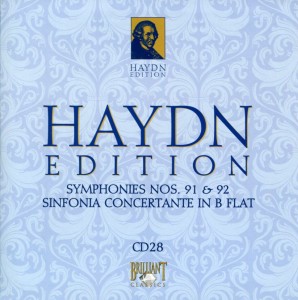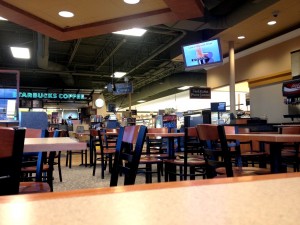 What happens when Panera just doesn’t cut it any more, when the thought of another Light Roast coffee or Asiago bagel curls one’s teeth?
What happens when Panera just doesn’t cut it any more, when the thought of another Light Roast coffee or Asiago bagel curls one’s teeth?
D&W to the rescue.
I’m not sure what D&W stands for. I’m sure it’s probably the names of its founders, like Dick and Wally or something. But it’s a grocery story chain in West Michigan that’s been around forever.
This morning, D&W’s bright, airy (and chilly!) cafeteria plays host to a few guys with laptops (including me) who are using it as an office.
 I see that a lot these days, people using Wi-Fi hotspots as remote offices. Nothing wrong with that. I do it all the time. It’s just interesting to see people with suits and ties (like the chap sitting directly in front of me in the next booth over) working on spreadsheets in a restaurant.
I see that a lot these days, people using Wi-Fi hotspots as remote offices. Nothing wrong with that. I do it all the time. It’s just interesting to see people with suits and ties (like the chap sitting directly in front of me in the next booth over) working on spreadsheets in a restaurant.
Ten years ago, a guy like that would have been at home, or at the office, but not in between in the professional equivalent of Purgatory.
In case you can’t see the sign, D&W sells Starbucks coffee, as most places do these days.
I don’t know why. Starbucks tastes like boiled car tires to me.
Granted, I used to like Starbucks. But, lately, that over-roasted (read: burnt) coffee-bean flavor makes me wince. Maybe I’ve had too many Light Roast coffees to go back to Starbucks.
was completed in 1788 as part of a three-symphony commission by Comte d’Ogny for the Concerts de la Loge Olympique. It is occasionally referred to as The Letter T referring to an older method of cataloguing Haydn’s symphonic output. The autograph manuscript bears a dedication to D’Ogny, but Haydn also gave Prince Krafft Ernst von Oettingen-Wallerstein a copy as if it were an original.
Haydn was 56.
Symphony No 92 in G “Oxford” (composed in 1787 when Haydn was 55) is called “Oxford”
because Haydn reportedly conducted it at a ceremony in 1791 in which he was awarded an honorary doctorate by Oxford University. The name is something of a misnomer, because the symphony was actually written earlier for performance in Paris. Haydn was awarded his degree fairly soon after his first arrival in England, and as he had not yet finished composing any of the twelve “London” symphonies he ultimately wrote for England, he brought to the ceremony the most recent of his completed symphonies.
Haydn’s appearance at Oxford was symbolic of the international success he attained beginning in his late fifties.
That makes me happy. I’m glad Haydn grew more popular the older he got. Far better than fading into obscurity, only to be heard on one of those “Where Are They Now?” radio programs, sort of the flip side of the Top Ten Countdown.
Siinfonia Concertante in B Flat for Violin, Cello, Oboe & Bassoon is an odd duck. For one thing, the soloists are named on the CD sleeve: Rainer Kuchl (violin), Wolfgang Herzer (cello), Gerhard Turetschek (oboe), and Michael Werba (bassoon). It’s still Adam Fischer conducting the Austro-Hungarian Haydn Orchestra. But these four musicians get special notice on the CD sleeve, which I think is quite cool.
Another thing that sets this musical composition apart is that, according to its entry on Wiki,
It is believed to be a response to similar works composed by Ignaz Plevel, a former student of Haydn’s who London newspapers were promoting as a ‘rival’ to Haydn.The composition was written during the first of the composers two visits to London. It is believed that Jonathan Peter Salomon asked Haydn to compose the work because of the success of similar works written by Pleyel and performed in a rival concert series.
Manuscript evidence indicates that the work was written in some haste and Hayden is known to have complained of eyestrain while working on it.
I find that interesting. A former student starts to gain notoriety and suddenly Haydn has to prove that he’s better than his student? Sounds like something out of a soap opera.
I wonder if “Dr. Haydn” (as he could now be called because he was awarded the honorary doctorate) was pissed at the suggestion to whip up something to show his former student who the teacher still was. Or was he insulted that he had to prove himself like that?
Either way, Sinfonia Concertante was composed within about a month in 1792 (February – March). Haydn was 60, or just a few days away from turning 60. You’d think by that point in his life he wouldn’t have to respond to a whippersnapper. (This is like a Western movie in which the young piss-and-vinegar gunslinger has to take on the old pro. If he outdraws him, he becomes the new top gun. If he doesn’t, well, Boot Hill would attain another long-term guest.)
Today’s symphonies were okay. I think my favorite of the three is the third — the hastily written Sinfonia. Once I discovered Haydn had to scribble it out to remind everyone who the master still was, I developed a liking for this piece, which someone posted on YouTube:

I love being able to listen to the music. Have this little link with the photo up at the top of each day’s story so that I can listen to the music while reading about it. 🙂 I would LOVE that! And after I’m done reading, I can continue to listen to it.
Why did you choose Haydn to start with? Why do you love Haydn? What are you continuing to discover about Haydn that informs your day at Panera or Starbucks?
This is a GREAT idea!
Hi Udana,
Thanks for stopping by!
I chose to start with Haydn because 4-5 years ago I began to collect the complete works of the Classical musicians — from Mozart to Bach to Beethoven to Haydn, Brahms, Chopin, and more. I have already listened to all of Mozart’s music (180 Days With Mozart and Me). I wanted to hear a contemporary of Mozart’s to see how the two composers influenced each other.
I love pretty much all Classical music. But what I love just as much is putting it in context. That’s why with each day’s entry, I listed Haydn’s age and make sure we know what year it was composed and performed. In previous entries, I put Haydn’s composition in context of what was going on in the world — the birth of the U.S., for example. Prominent authors at the time. Other composers. That makes the composer’s life concrete, real, not just the stuff of legend.
After Haydn (in February or so), I’ll switch to the complete works of Woody Allen (everything he directed). That’s about 40 days. After that, hmmm, let’s see. I think it’s the complete works of Beethoven, who was a student of Haydn’s and who, on at least one occasion, spent time hanging out with Mozart (if memory serves).
After that, it’s both Gatsby novels — the one everyone knows, and the one Fitzgerald wrote that become The Great Gatsby novel we all know and love. At the same time, I’ll watch both Gatsby movies — the 1974 version with Redford and Farrow, and the most recent one, with DiCaprio and Mulligan.
But it’s not just the music. What I also love about these projects is what I learn around the music, or about myself. I learn new instruments, new anecdotes (like “Haydn’s head,” which is a story unto itself), or about what’s going on in my life at the time. A great example of something learned is when I listened to Mozart. I discovered opera singers and the Glass Harmonica, a truly weird instrument that I’d never heard of before.
Check back now and then. It’s going to be fun.
Bill
Not bad at all for being hastily written as a challenge! Hard to believe a guy like Haydn would have to prove himself!